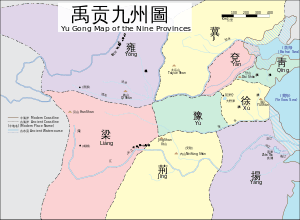Qing Province
Qingzhou or Qing Province was one of the Nine Provinces of ancient China dating back to c. 2070 BCE that later became one of the thirteen provinces of the Han dynasty (206 BCE–220 CE). The Nine Provinces were first described in the Tribute of Yu chapter of the classic Book of Documents, with Qingzhou lying to the east of Yuzhou and north of Yangzhou. Qingzhou's primary territory included most of modern Shandong province except the southwest corner.
| Qing Province | |||||||
|---|---|---|---|---|---|---|---|
 A conjectural reconstruction of the Nine Provinces of ancient Chinese geography | |||||||
| Chinese | 青州 靑州 | ||||||
| Hanyu Pinyin | Qīngzhōu | ||||||
| Literal meaning | Azure Province | ||||||
| |||||||
History
Ancient times
The territory takes its name from the Tribute of Yu wherein Yu the Great wrote: "Between the sea and Mount Tai there is only Qingzhou".[lower-alpha 1] In around 5,000 BCE the area was the cradle of Dongyi culture.[1] During the Xia and Shang dynasties, it was home to the Shuangjiu (爽鸠, Shuǎngjīu), Jize (季则, Jìzé), and Pangboling (逄伯陵, Pángbólíng) clans and the state of Pugu.
Zhou dynasty
Following the Duke of Zhou's c. 1040 BCE successful campaign against the Dongyi states allied with the revolting Three Guards and the rebellious Shang prince Wu Geng, the captured territory of Pugu was granted to Jiang Ziya as the marchland of Qi.[2]
Han dynasty

In 106 BCE, Emperor Wu formally divided the Han Empire into 13 provinces[3] and appointed a Regional Coordinator (Chinese: 刺史; pinyin: cìshǐ; also translated as Inspector) in Qingzhou.[1] With the coming of the Eastern Han dynasty in 25 CE, the seat of a local administration moved from Qingzhou to the former Qi capital of Linzi (present-day Linzi District, Zibo, Shandong). In Eastern Han, Qing Province consisted of 5 commanderies, namely Pingyuan, Jinan, Beihai, Qiansheng, Donglai, and the kingdom/principality of Qi.
Tang dynasty
During the Tang dynasty (618–907), Qingzhou held jurisdiction over the seven counties of Yidu (益都), Beihai (北海), Linqu (临朐), Linzi (临淄), Qiancheng (千乘), Bochang (博昌) and Shouguang (寿光) with the administrative centre based in Yidu County.
Northern Song dynasty
The administrative centre of Qingzhou remained in Yidu County during the Northern Song dynasty (960–1127) with the number of counties reduced to six by the removal of Beihai County.
Notes
- Chinese: 海岱惟青州, Hǎi Dài wéi Qīngzhōu.
References
- This article is partly based on a translation of 青州 in the Chinese Wikipedia
- "Introduction to Qingzhou (青州城市概況)" (in Chinese). Qingzhou Government Website. Archived from the original on January 16, 2014. Retrieved January 13, 2014.
- China: Five Thousand Years of History and Civilization. City University of Hong Kong Press. 2007. ISBN 978-9629371401.
- Hucker, Charles O. (2008). A Dictionary of Official Titles in Imperial China. Beijing University Press. ISBN 9787301134870. p.14